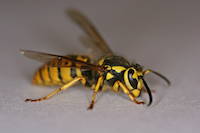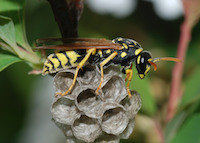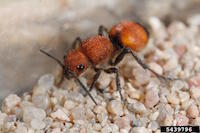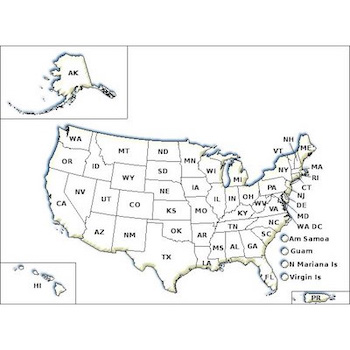Insects such as bees, wasps, and fire ants use a stinger to defend themselves when they feel threatened. They may be beneficial or unwanted depending on where they are found. Some bees, paper wasps, and hornets may build nests in attics, walls, under eaves, and in tree branches.
Other insects such as velvet ants, yellowjackets, and some bees build their nests in the ground. Many of these insects feed on nectar or other sweet-smelling foods such as fallen fruit and soft drinks. Others may also eat meat, other insects, or oils. Social insects such as honey bees, hornets, yellowjackets, and paper wasps can build colonies containing thousands of workers. Solitary insects such as mud daubers and velvet ants may live alone or in small groups.
Control Tips:
- If you or someone else has been stung and are allergic or sensitive to stings, call the Poison Control Center (800-222-1222) or your healthcare provider right away.
- Identify your pest! Beneficial insects and unwanted species may look similar.
- Monitor for nest-building insects. Inspect trees, open structures, eaves, soffits, and holes in walls and structures.
- Knock down new nests early in the season.
- Remember that many bees and wasps nest on or in the ground. Always wear shoes when walking through your yard.
- Deter stinging insects by limiting food and water sources. Tightly seal garbage bins, get rid of soft drink cans and food containers, keep pet food covered or indoors, and dispose of fallen fruit.
- Lure traps can limit pest presence in the area. Be sure to keep lure traps away from patios, porches, or entrances to buildings and homes.
- Properly seal doors, windows, and cracks in your foundation, vents, and walls.
- Reduce debris in and around the yard to limit shelter for pests.
- Consider not planting flowering trees, shrubs, and flowers close to entrances of buildings and homes. They may attract stinging insects to the area.
- Consult a professional for nest removal.
- Always read and follow label directions for any pesticide product.
If you have questions about this, or any pesticide-related topic, please call NPIC at 800-858-7378 (8:00am - 12:00pm PST), or email us at npic@oregonstate.edu.
Last updated October 14, 2025
- Identify your pest. Some stinging insects are beneficial to lawns and gardens. Control techniques may not be needed.
- Monitor nest-building insects. Inspect trees, open structures, eaves, soffits, and holes in walls and structures.
- Knockdown new nests early in the season. Contact a professional if you are worried about getting stung.
- Deter insects by limiting food and water sources (such as garbage bins, fallen fruit, and soda cans).
- Lure traps can limit pest presence in the area.
- Properly seal doors, windows, and cracks in your foundation, vents, and walls.
- Reduce debris in and around the yard to limit shelter for pests.
- Consider not planting flowering trees, shrubs, and flowers close to entrances of buildings and homes. They may attract stinging insects to the area.
- If you are allergic or sensitive to stings, call the Poison Control Center (800-222-1222) or your health care provider right away.
- Treat at night when insects are less active.
- If you choose to use a pesticide, always follow the label. Try a lower toxicity product first.
- If you have a pesticide product in mind, have your label handy and click here for information about that product.
These images are graciously allowed to be used by NPIC by Bugwood.org. Images included in the Bugwood Network Image Archives (ForestryImages.org, IPMImages.org, Invasive.org, and InsectImages.org) are made available under a Creative Commons license. Individual photographers retain all rights to images included in the archive.
Bees

All bee species are considered to be beneficial as pollinators. Bees can live in many different locations, with many nesting below ground. They are attracted to different plants depending on the type of bee and where they live.
Additional Resources:
Scorpions

Scorpions are easy to identify with their pincers, stinger, and sectioned tail. They like to hide in enclosed areas, which can include shoes and boots. Their sting can cause swelling and severe pain, numbness, and convulsions.
Additional Resources:
Stinging Caterpillars

Often found in wooded areas, stinging caterpillars have hairs or hooks that are connected to sacs of poison. When touched, the hairs or hooks break and release the poison. This poison can cause mild to severe itching and pain, or intestinal issues.
See our webpage about other caterpillars for more information.
Additional Resources:
Hornets, Wasps, and Yellowjackets

Hornets and yellowjackets are social wasps and can build nests with many members. Their nests may be placed in exposed areas or in burrows below ground. Yellowjackets and hornets can be very aggressive and, unlike bees, they can sting repeatedly. If threatened, they can also release an alarm signal telling others in the nest to attack.
Additional Resources:
Hornets
Wasps
Yellowjackets
Paper Wasps

Paper wasps often use roof eaves and overhangs to build nests and can overwinter in attics. Unlike hornets and yellowjackets, they’re not normally aggressive. However, they can defend their nest if threatened.
Additional Resources:
Velvet Ants

Velvet ants are actually wasps. They often live alone in nests built by other creatures and mostly feed on nectar and water. Velvet ants wander randomly on the ground and can produce a painful sting. Female velvet ants are wingless and are the only ones that can actually sting.
Additional Resources:
Through its county agents, the Cooperative Extension Service gives individuals access to the resources at land-grant universities across the nation. These universities are centers for research in many subjects, including entomology (the study of insects) and agriculture. Each county within the United States has an Extension office, which is staffed with agents who work closely with university-based Extension specialists to deliver answers to your questions about gardening, agriculture, and pest control.









